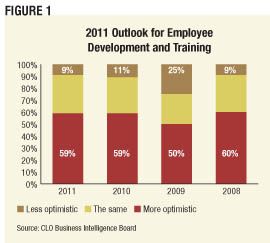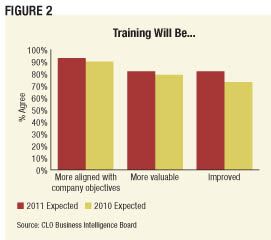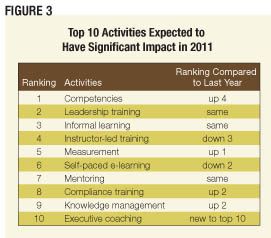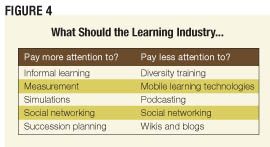Every other month, IDC surveys Chief Learning Officer magazine’s Business Intelligence Board (BIB) on a variety of topics to measure the attitudes, issues and interests of senior training executives. This month’s topic is outlook on training, and this article will discuss the survey responses of 238 BIB members as well as compare the results to similar survey data from past years.
Things Are Looking Up
Good news: Executives are increasingly optimistic about the outlook for employee development in 2011, with 60 percent of companies feeling more optimistic in 2011 compared to 2010. In fact, the percentage of CLOs who are “less optimistic” about 2011 has declined to rates last seen in 2008. CLOs have passed through a difficult period that has resulted in “a greater appreciation of internal knowledge to support informal training.”

The reasons for optimism are not surprising; “as the economy slowly recovers, so will the training industry,” and “investing in development will be the least expensive and most effective thing a company can do to stay competitive.” Training organizations and the wider enterprise seem to have “more focus on outcome, value and usability of learning,” “as long as learning leaders [align] what they are doing to the business goals.”

Despite optimism, economic conditions haven’t returned to pre-crisis levels and likely will continue to affect training budgets. Nevertheless, Figure 2 indicates that companies are expecting increased positive developments in the role the training function plays within their companies. Compared with last year:
- More CLOs expect training to be more aligned with company business objectives.
- More CLOs believe the perception of training within their company will increase.
- More CLOs believe the quality of their training offerings will improve.
Instructor-Led, Self-Paced Training to Increase Impact
The ranking of activities’ impact in 2010 shows movement, though leadership training and competencies remain at the top. Instructor-led training — including classroom and virtual classroom instruction — has become the most impactful training activity. Informal learning remains near the top, and self-paced e-learning has moved up.
Three items that were on the list last year but are no longer in the top 10 include performance management systems and live e-learning. These could be lurking below the surface with many CLOs, but their popularity clearly has waned.
When asked about the “most important” activity, CLOs listed competencies above leadership and various delivery methods. This is an interesting change; competency had been rated as most significant before the economic crisis, which may have boosted appreciation for its value.
Key activities of significant impact are:
Competencies: Competencies are valuable because they “help define a foundation for future development activities” and are “a good linkage between business goals and training.” Formally, competency models form the foundation to develop job descriptions, recruiting criteria, performance objectives and the associated curriculum and training materials. “The company’s philosphy is to hire, train [and] reward the best we can find. That starts with getting the right people on the bus. But getting the right people also requires a thorough understanding of the competencies, skills and abilities of candidates. We believe that an enterprisewide focus on competencies not only drives recruiting, but extends to on-boarding and training of new staff.” Tailoring on-boarding programs to a new employee’s competencies is a sophisticated approach to achieve rapid productivity.
Leadership training: Leadership training continues to be a hot-button issue as companies work to support corporate succession initiatives. “Developing current and future leaders is core to our culture.” Upgrading leaders in an organization has become more important in light of talent shortages and an aging workforce and the “significant retirements we will see in the next three to four years.” Companies focus on different elements of leadership depending on their requirements: for internal customer service, team relations or reducing turnover. Ultimately it’s designed to “help them better do what they do.”
Informal learning: Informal learning also has become a key activity, and not only because of economic hardships and training budget cuts. Many companies see informal training as the model to aspire to as training becomes integrated into everyday interactions and work culture. Companies increasingly understand that most learning occurs outside of formal settings — “most of the peer-to-peer coaching is informal” — and “we need to increasingly push learning into the workplace.”
Self-paced e-learning: Even though self-paced, asynchronous e-learning has been available for many years, it has not been widely leveraged for non-technology topics. But now “we are developing rapid e-learning to support our sales efforts” primarily because “we don’t have the staff to support large-scale training, so e-learning will be the most viable option.” Organizations also are differentiating between good training and bad: When they’re produced well, e-learning courses can have a positive impact on performance, which is “a good return on the investment.”
Live e-learning: As with self-paced e-learning, “cost cutting means more focus on e-learning. Outcomes are improved with an online mentor/facilitator.” “Synchronous online training allows the learners to have contact with a subject-matter expert who is training or the facilitator.” Economic conditions are causing CLOs to consider delivery methods that retain the essential characteristics of traditional learning experiences, but also increase the availability of classes for non-local learners. “More of our staff will be able to receive training that has only been available with a plane ticket [before].”
Instructor-led training: Instructor-led training is still valued for “high interaction and early validation of learning transfer, capabilities and plans to apply knowledge.” For many, it is “still the primary delivery modality for teaching for understanding.”

More Attention Needed
CLOs think informal learning deserves more attention in 2011, as they have for the past two years. At the same time, social networking is both lauded and condemned for its popularity.
Simulations also are gaining more attention from the learning industry. Informal instruction and simulations are highly experiential — relying on real work situations to be the catalyst for valuable learning experiences. For some, this is about effectiveness; it “goes beyond individual skills to team performance improvement.” For call center representatives, for example, it accurately re-creates the need for “multitasking capabilities.”
Whichever methods are chosen, organizations insist that “all initiatives show how [they] influenced the business.” Measurement demonstrates “alignment with business and management goals.” Having a clear goal is essential to success. For succession planning it is the same: “It covers identification of gaps, but it also is the building block on which all training is based.”
At the same time, the learning industry must take a step back on some issues. Many CLOs believe podcasting is oversold because “mobile learning has a limited application in most work environments,” and it’s “not a new idea.” And, at the same time, wikis and blogs, for instance, have less value than attributed in the press because “there is so much junk and misinformation [that it] is more damaging than useful.” Many feel “far too often wikis and blogs are a source of opinions, not facts.”

Predictions for 2011: Back to the Basics
Much about this upcoming year is uncertain, and many CLOs see 2011 as “another challenging year.” Challenges from hiring to retirements and job changers will increase the importance of the training function, specifically greater emphasis for online, asynchronous training and more informal learning assets in lieu of formal training.
But only 43 percent expect budget increases — up from last year’s 37 percent — and more than two-thirds of CLOs expect their organizations to develop more custom content and to deliver more training themselves. Therefore, training departments will continue to “do more with less.”
CLOs offered hundreds of predictions for the upcoming year, many of which were related to the broader economy and its impact on the training industry:
“As the economy slowly recovers, so will the training industry.”
“In 2011, the training industry will be impacted by the economy as a whole.”
“The recession will be longer than anticipated, and organizations will be careful about any expenditures due to the uncertainty in the business world.”
Many predictions were focused on content and methods. For instance, lots of them were related to a desire for more informal learning, but the debate between functional and managerial skills remained: “Executive and leadership development will have the biggest impact” and be “more skills focused than leadership focused.” This implies a healthy balance remains between both areas of development. Also, there will be an ongoing increase in technology in the classroom and an “increase in the use of the virtual world for simulations and augmented reality for complex task training.”
But many also implied that there is a changing role or relationship between the business and employee development:
How: “Agility will be the key to success,” though “emphasis will be placed upon getting more accomplished with less resources.”
Impact: Training will be “focused on results and more integration with actual work” and include a “greater emphasis on performance improvement” with a “focus on measurement” and “training outcomes.”
Overall, companies believe the outlook for the learning function is similar to industries overall — it will be difficult, but there will be positive developments in the way organizations leverage and align learning, use tools and refocus on providing value to the organization.
Cushing Anderson is the program director of learning services at IDC. He can be reached ateditor@clomedia.com.















